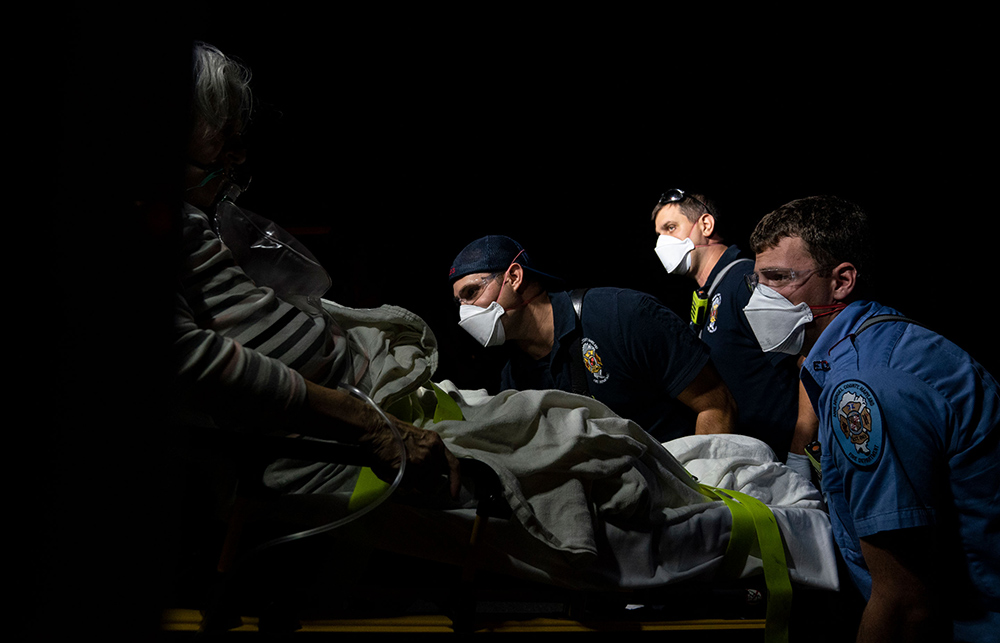
輝瑞和BioNTech公司宣布的候選新冠病毒疫苗結果喜人,標志著他們在朝著戰勝新冠疫情的道路上邁出了重要一步。在接下來的幾個月中,即便做一次中等規模的疫苗分發,也能夠保護數百萬人免于疾病,挽救數萬人的生命。
但如果要真正擊退新冠肺炎,我們就需要群體免疫。只有一種方法可以確保這個目標的達成:為全球77億人口中至少75%的人接種有效的疫苗。
要實現這一目標,我們必須對目前的生產、交付和疫苗獲得人群的臨時方法作出大幅調整。按照當前的計劃,世界上四分之三的人口永遠不可能得到疫苗接種——這意味著我們沒有一個人會真正安全。
科研人員和許多國家的領導人拒絕通過感染的方式來達成群體免疫,因為這個方式增加了病毒在南北半球之間來回傳播時產生季節性突變的惡性循環的風險——類似于流感的年際“進化”。
但這也并不是說,成功研發出有效的疫苗就意味著全部的答案。
據新冠肺炎疫苗實施計劃(COVAX)稱,各國政府應該優先向最易受病毒感染的人群,諸如衛生保健工作者、年長者和有潛在健康問題者等人群提供新冠疫苗。這樣的舉措將有效減少死亡人數,減輕衛生保健系統的壓力。
但如果我們只給最易感的人群接種疫苗,那么新冠病毒將繼續在世界上人口最多的一系列國家中,在常表現為無癥狀的年輕人群體中大面積蔓延。
今年9月,《科學》雜志(Science)發表了一篇關于印度年輕人感染率的研究,證明了接種疫苗計劃的重要性。他們罹患新冠的比率比美國年輕人高得多,這意味著感染范圍很廣——因為印度的中位年齡是28歲,只有6%的人口被定義為老年人。但在美國,中位年齡是38歲,65歲及以上的人口占17%。
無癥狀感染也會產生后果。隨著無癥狀感染的廣泛傳播,突變的可能性增加,新冠病毒成為永久性風險的可能性也會增加。新冠病毒的突變要比流感病毒慢得多,但每感染一個新的人,就更有可能產生突變。
如果我們未能及時為全球數十億年輕人接種疫苗,任由他們感染,我們可能會在不經意間培育出一種新的流行病——因為一種突變的病毒可能會成為一種全新的疾病,對目前正在開發的疫苗無效,我們在群體免疫方面取得的任何進展也都將功虧一簣。
全球疫苗接種必須在短時間內完成,以確保病毒不會發生顯著突變,逃離我們的掌控。我們將獲得的終生免疫,不是來自某一種完美的疫苗,而是通過給我們中的大部分人接種疫苗,從而使病毒缺失宿主,逐漸消失。
疫苗研發和生產的努力讓人動容,但由于致命缺陷——生產,它們距離通過接種來實現群體免疫差得還很遠。
要理解這一挑戰有多大,不妨以流感疫苗為例:每年流感疫苗的產量最高為15億劑。從公開聲明來看,III期臨床試驗的主要公司——Moderna、阿斯利康、強生和輝瑞及BioNTech——到2021年年底,這些公司加在一起只能為20億人接種疫苗,還不到所需量的三分之一。
即便是這樣的預測也已經相當樂觀了。在目前臨床試驗的所有疫苗都獲得批準的情況下,供應鏈方面的約束將束縛產量。制造商們將爭奪關鍵成分有限的原料,包括核苷酸和酶等生物原料,以及瓶子和瓶蓋這些更普通的配件。
一旦疫苗生產出來,交付過程也會面臨一系列挑戰。假設輝瑞、BioNTech的疫苗跨過了最后的監管障礙,其需要在零下80攝氏度的極端低溫儲存。對美國和其他能夠負擔得起每劑數千美元的國家來說,極低溫冷鏈可能可行,但對墨西哥、巴西、尼日利亞、印度或印度尼西亞來說,可行性堪憂。在主要的疫苗競爭公司中,只有強生公司生產的一種疫苗在運輸過程中不需要特殊處理。
為了克服冷鏈的挑戰,我們需要能夠在當地生產的疫苗,在最低的冷藏條件下實現交付,并在基本衛生保健基礎設施下進行接種。要做到這一點,我們必須從更廣泛的角度考慮疫苗生產和投資。
最初,大量投資都在美國和英國進行,現在,我們必須在世界各地投資那些技術足以制造疫苗,且成本低廉的公司。我們有能力通過信使RNA做到這一點——信使RNA將DNA轉化成一種模擬冠狀病毒上發現的蛋白質,幫助身體建立免疫。
一旦我們可以確保本地生產,創新性的交付解決方案就能夠實現。我們可以把小冰箱裝在可口可樂等送貨卡車上,當這些卡車為偏遠村莊的街角商店提供補給時,同時能夠提供疫苗。教師和當地宗教領袖可以接受相關管理培訓。
實現群體免疫的最后一公里困難重重,我們需要深思熟慮各種方法,充分利用世界各地的私營企業、衛生部門和非政府組織的智慧、技能和創造力。如果不能盡快這樣做,所有這些痛苦和努力都將付諸東流。(財富中文網)
本文作者安德烈?扎魯爾是總部位于波士頓的RNA研究、開發和制造公司GreenLight Biosciences的首席執行官。
編譯:楊二一
輝瑞和BioNTech公司宣布的候選新冠病毒疫苗結果喜人,標志著他們在朝著戰勝新冠疫情的道路上邁出了重要一步。在接下來的幾個月中,即便做一次中等規模的疫苗分發,也能夠保護數百萬人免于疾病,挽救數萬人的生命。
但如果要真正擊退新冠肺炎,我們就需要群體免疫。只有一種方法可以確保這個目標的達成:為全球77億人口中至少75%的人接種有效的疫苗。
要實現這一目標,我們必須對目前的生產、交付和疫苗獲得人群的臨時方法作出大幅調整。按照當前的計劃,世界上四分之三的人口永遠不可能得到疫苗接種——這意味著我們沒有一個人會真正安全。
科研人員和許多國家的領導人拒絕通過感染的方式來達成群體免疫,因為這個方式增加了病毒在南北半球之間來回傳播時產生季節性突變的惡性循環的風險——類似于流感的年際“進化”。
但這也并不是說,成功研發出有效的疫苗就意味著全部的答案。
據新冠肺炎疫苗實施計劃(COVAX)稱,各國政府應該優先向最易受病毒感染的人群,諸如衛生保健工作者、年長者和有潛在健康問題者等人群提供新冠疫苗。這樣的舉措將有效減少死亡人數,減輕衛生保健系統的壓力。
但如果我們只給最易感的人群接種疫苗,那么新冠病毒將繼續在世界上人口最多的一系列國家中,在常表現為無癥狀的年輕人群體中大面積蔓延。
今年9月,《科學》雜志(Science)發表了一篇關于印度年輕人感染率的研究,證明了接種疫苗計劃的重要性。他們罹患新冠的比率比美國年輕人高得多,這意味著感染范圍很廣——因為印度的中位年齡是28歲,只有6%的人口被定義為老年人。但在美國,中位年齡是38歲,65歲及以上的人口占17%。
無癥狀感染也會產生后果。隨著無癥狀感染的廣泛傳播,突變的可能性增加,新冠病毒成為永久性風險的可能性也會增加。新冠病毒的突變要比流感病毒慢得多,但每感染一個新的人,就更有可能產生突變。
如果我們未能及時為全球數十億年輕人接種疫苗,任由他們感染,我們可能會在不經意間培育出一種新的流行病——因為一種突變的病毒可能會成為一種全新的疾病,對目前正在開發的疫苗無效,我們在群體免疫方面取得的任何進展也都將功虧一簣。
全球疫苗接種必須在短時間內完成,以確保病毒不會發生顯著突變,逃離我們的掌控。我們將獲得的終生免疫,不是來自某一種完美的疫苗,而是通過給我們中的大部分人接種疫苗,從而使病毒缺失宿主,逐漸消失。
疫苗研發和生產的努力讓人動容,但由于致命缺陷——生產,它們距離通過接種來實現群體免疫差得還很遠。
要理解這一挑戰有多大,不妨以流感疫苗為例:每年流感疫苗的產量最高為15億劑。從公開聲明來看,III期臨床試驗的主要公司——Moderna、阿斯利康、強生和輝瑞及BioNTech——到2021年年底,這些公司加在一起只能為20億人接種疫苗,還不到所需量的三分之一。
即便是這樣的預測也已經相當樂觀了。在目前臨床試驗的所有疫苗都獲得批準的情況下,供應鏈方面的約束將束縛產量。制造商們將爭奪關鍵成分有限的原料,包括核苷酸和酶等生物原料,以及瓶子和瓶蓋這些更普通的配件。
一旦疫苗生產出來,交付過程也會面臨一系列挑戰。假設輝瑞、BioNTech的疫苗跨過了最后的監管障礙,其需要在零下80攝氏度的極端低溫儲存。對美國和其他能夠負擔得起每劑數千美元的國家來說,極低溫冷鏈可能可行,但對墨西哥、巴西、尼日利亞、印度或印度尼西亞來說,可行性堪憂。在主要的疫苗競爭公司中,只有強生公司生產的一種疫苗在運輸過程中不需要特殊處理。
為了克服冷鏈的挑戰,我們需要能夠在當地生產的疫苗,在最低的冷藏條件下實現交付,并在基本衛生保健基礎設施下進行接種。要做到這一點,我們必須從更廣泛的角度考慮疫苗生產和投資。
最初,大量投資都在美國和英國進行,現在,我們必須在世界各地投資那些技術足以制造疫苗,且成本低廉的公司。我們有能力通過信使RNA做到這一點——信使RNA將DNA轉化成一種模擬冠狀病毒上發現的蛋白質,幫助身體建立免疫。
一旦我們可以確保本地生產,創新性的交付解決方案就能夠實現。我們可以把小冰箱裝在可口可樂等送貨卡車上,當這些卡車為偏遠村莊的街角商店提供補給時,同時能夠提供疫苗。教師和當地宗教領袖可以接受相關管理培訓。
實現群體免疫的最后一公里困難重重,我們需要深思熟慮各種方法,充分利用世界各地的私營企業、衛生部門和非政府組織的智慧、技能和創造力。如果不能盡快這樣做,所有這些痛苦和努力都將付諸東流。(財富中文網)
本文作者安德烈?扎魯爾是總部位于波士頓的RNA研究、開發和制造公司GreenLight Biosciences的首席執行官。
編譯:楊二一
The promising results announced by Pfizer and BioNTech in their coronavirus vaccine candidate mark a significant step toward overcoming COVID-19. Even a modest deployment in the next few months could protect millions of people and save tens of thousands.
To beat back this pandemic, however, we need herd immunity. And there’s only one sure way to get that: We must inoculate at least 75% of the world’s 7.7 billion people with an effective vaccine.
Achieving this requires a sharp shift from our current ad hoc approach to production, delivery, and policies on who will get the vaccine. With the current plans, there is no way that three-quarters of the world will ever be vaccinated—which means none of us will truly be safe.
Reaching herd immunity via infection has been rejected by scientists and many world leaders because it raises the risk of creating a vicious cycle of seasonal mutation as the virus bounces between the world’s northern and southern hemispheres, similar to influenza’s annual evolution.
But that doesn’t mean that the discovery of a potent vaccine is the whole answer, either.
According to a new global partnership of health organizations called COVAX, authorities should prioritize giving a COVID vaccine to those most vulnerable to the virus—health care workers, the elderly, and those with underlying health conditions. This will reduce deaths and alleviate stress on health care systems.
Yet, if we vaccinate only the most vulnerable, the virus will continue to sweep through large swaths of often asymptomatic young people in some of the world’s most populous nations.
Evidence for the importance of a successful vaccination program came in September, when a study was published in Science about rates of infection in young people in India. They are getting COVID at a much higher rate than are young people in the U.S. That translates into widespread infection, because India’s median age is 28, with only 6% of the population defined as elderly. In the U.S., however, the median age is 38, and 17% of the population is 65 or older.
Infections without symptoms have consequences. With wide asymptomatic spread, there will be more mutations and more risk that the virus will become permanent. Coronaviruses mutate far more slowly than influenza viruses do, but the opportunity increases with each new person infected.
By failing to swiftly vaccinate the world’s billions of young people, and allowing them to become infected, we could inadvertently nurture a new pandemic. A mutated virus could become an entirely new disease that sidesteps the vaccines now under development and whatever progress we have made toward herd immunity.
Global vaccination must be done in a brief time frame to make sure the virus doesn’t significantly mutate and thus evade our grasp. We will all get lifetime immunity not by having a perfect vaccine, but by vaccinating so many of us that the virus has no hosts and fades away.
As impressive as vaccine development and production efforts have been to date, they will fall well short of achieving herd immunity through inoculation because of a shortcoming on the most basic level: production.
To understand the scale of the challenge, consider that production of the annual influenza vaccine tops out at 1.5 billion doses each year. From their public statements, it looks like the main companies in Phase III clinical trials—Moderna, AstraZeneca, Johnson & Johnson, and Pfizer/BioNTech—could together make only enough to inoculate 2 billion people by the end of 2021, less than a third of what is needed.
Even these projections are highly optimistic. In the unlikely event that all the vaccines currently in clinical trials are approved, supply chain constraints will hamper output. Manufacturers will be competing for the limited supply of critical components, including biological raw materials like nucleotides and enzymes as well as more mundane supplies such as vials and caps.
Once produced, delivery presents its own set of challenges. Pfizer/BioNTech’s vaccine, assuming that it passes the final regulatory hurdles, requires extreme-cold storage at minus 80 degrees Celsius. An extreme-cold chain may be feasible for the U.S. and other countries that can afford to pay thousands of dollars per dose, but this is not a viable solution for Mexico, Brazil, Nigeria, India, or Indonesia. Of the leading vaccine contenders, only the one from Johnson & Johnson doesn’t require special treatment during transportation.
To overcome this cold chain challenge, we need vaccines that can be manufactured locally, delivered with minimal refrigeration, and administered with basic health care infrastructure. And to do that, we have to think more broadly about vaccine production and investment.
The large initial investments were made in the U.S. and the U.K. Now we must invest in companies around the world that can use technology that can easily manufacture a virus—and cheaply. We have the capability to do that with messenger RNA, which translates DNA into proteins that mimic the proteins found on the coronavirus and help the body build immunity.
Once we can assure local production, we can figure out creative delivery solutions. We could put small refrigerators in Coca-Cola and other delivery trucks. As they resupply corner stores in remote villages, they could deliver vaccines. Teachers and religious leaders could be trained to administer it.
Getting down that last dusty mile to achieve vaccine-led herd immunity requires rethinking our approach and harnessing the combined intelligence, skills, and creativity of private companies, health authorities, and nongovernmental organizations around the world. Unless we do that, quickly, all this pain and effort will be wasted.
Andrey Zarur is CEO of GreenLight Biosciences, a Boston-based RNA research, development, and manufacturing company.






